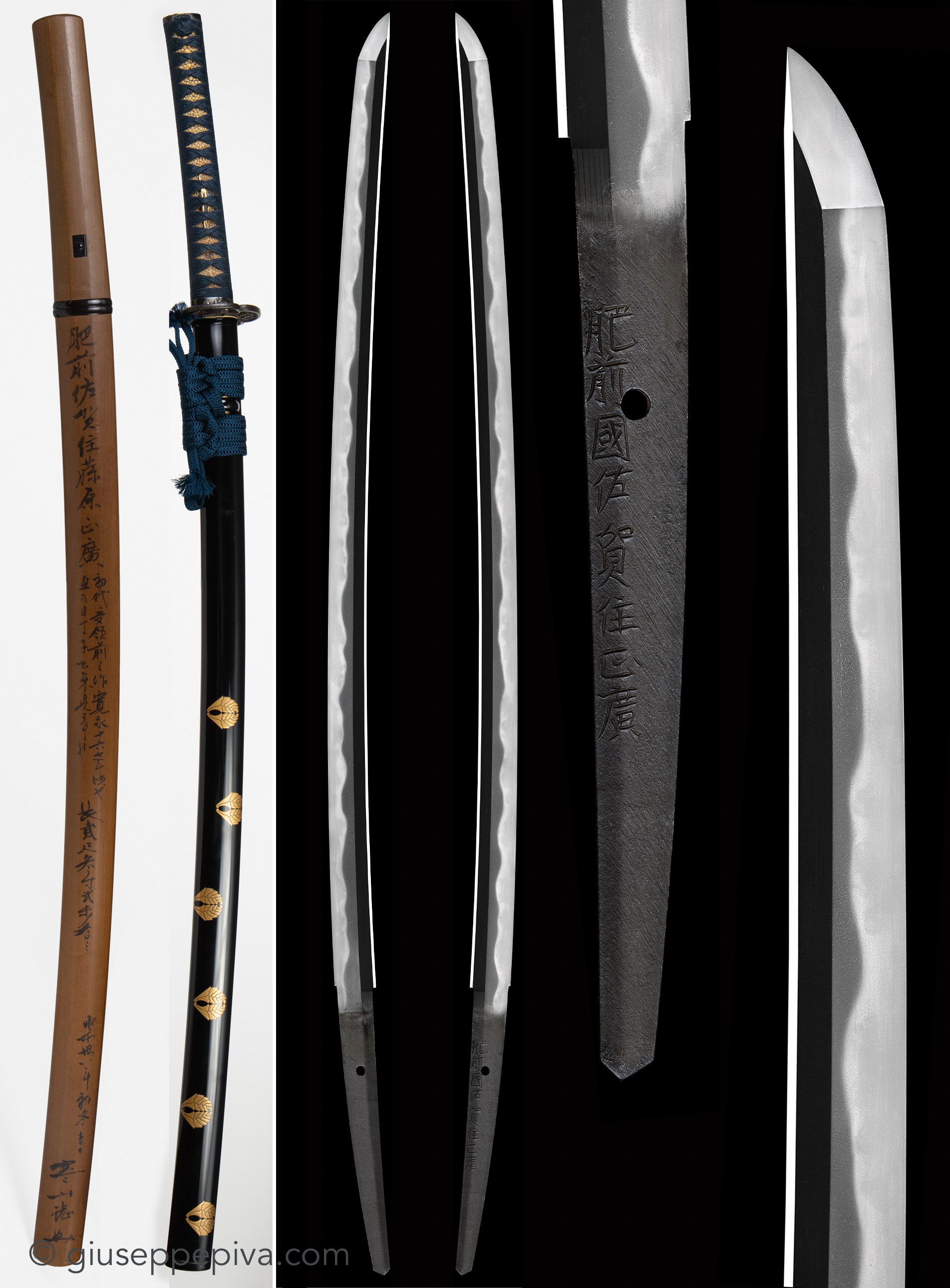Hizen Masahiro Katana
signed “Hizen kuni Saga Ju Masahiro”
肥前國佐賀住正廣
Edo period, Circa 1640
NBTHK Juyō Tōken
Measures
Nagasa [lenght]: 70.2 cm
Motohaba: 2.8 cm, sakihaba: 2 cm
Kasane [thickness]: 5.8 mm
Sori [curvature]: 1.82 cm
Sugata [configuration]
Shinogi-zukuri, koshi-zori, iori-mune, elongated chu-kissaki (3.6 cm)
Kitae [forging pattern]
Ko-itame hada with thick jinie and chikei
Hamon [tempering pattern]:
Nie-deki gunome and ō-gunome midare mixed to choji midare, the thick nioiguchi shows sunagashi, kinsuji, yo and ashi.
Bōshi [point]
Round at the end with hakikake kaeri
Horimono [carvings]
Bo-hi ni soe-bi. Large koshi-bi on ura side.
Nakago [tang]:
Ubu, iriyamagata-jiri, ō-sujikai yasurime; one mekugi-ana, mei: “Hizen Koku Saga Ju Fujiwara Masahiro”
Origami [papers]
The blade comes with a Juyō token (Important sword) certificate issued by the Nihon Bijutsu Token Hozon Kyokai (Session nr. 25)
Sayagaki: written by Kanzan sensei:
Hizen Saga Ju Fujiwara Masahiro
This blade was made early and it is assigned to the first generation, around Kanei 16 or 17
Gunome Midare and Choji Midare
Blade length is 2 shaku 3 sun 2 bu.
Kanzan Sato [+ kao]
Koshirae [mount]
The sword is accompanied by an antique koshirae with high level fittings; the lacquered scabbard with gold family crests representing apricot blossom used by the Nabeshima clan.
The Hizen school was one of the glorious successes of the Shintō period. It was founded by Tadayoshi, under the sponsorship of the daimyō Nabeshima Naoshige. The Tadayoshi style is based on the work of Yamashiro Rai, and swiftly gained and maintained a reputation for high quality swords, both beautiful and with an excellent cutting ability.
Born in 1607, Hashimoto Sadenji was Tadayoshi’s grandson and student. He is recorded signing his early works with the art name “Masanaga” but there are none existing and, according to the dai-mei tradition, he was probably using more often his master’s name, which in the meantime had changed from Tadayoshi to Tadahiro. In 1624 he made a sword in front of the feudal lord Nabeshima Katsushige, who granted him the smith-name “Masahiro” with a stipend of 20 koku, which could support 20 people, and the possibility to sign his works and to start his own lineage. It is important to note that the daimyō Nabeshima engaged Masahiro directly, due to his superior ability. In 1628 Masahiro is documented to be entitled to use the qualification “Kawachi Daijo” but it seems that for some reasons he chose not to add it to his signature until 1641.
Even if the main style of the Hashimoto family was based on suguha hamon, Masahiro worked mainly in midare, as seen on this blade. The reason might be that the daimyō Nabeshima, who commissioned the work, was very fond of Soshu Gō’s style, who used a midareba with strong nie. Masahiro’s style might look similar to Tadahiro, but it is actually more flamboyant, with strong nie which gives origin to sunagashi and kinsuji, especially on early blades like the present one. Another feature of early works is the hakikake boshi and in fact Kanzan sensei dated this katana at 1639-40.
Masahiro is considered the best smith among all Waki-Hizen schools, which means those who were not in the direct lineage of Tadayoshi. He was in fact one of the best sword-smiths of the Shintō period and he is rated “Jo Saku” (“Superior”) by Fujishiro. He died in 1665 at the age of 59 and his name had been used by his descendants for ten generations until the end of the Edo period.
This katana gives a very strong feeling, with a wide blade and a flamboyant hamon, rich of activities; it clearly shows the best traits of Masahiro and is considered an important work, being appointed as “Juyō Tōken” as early as 1977, a clear evidence of how soon it had been recognised as a masterpiece.
Price band: over 50,000€
INVENTORY NUMBER: tok-1616
Katana for sale.
Inventory Nr: 1616
Info works
Copyright © 2016 - giuseppe piva - VAT: 05104180962














